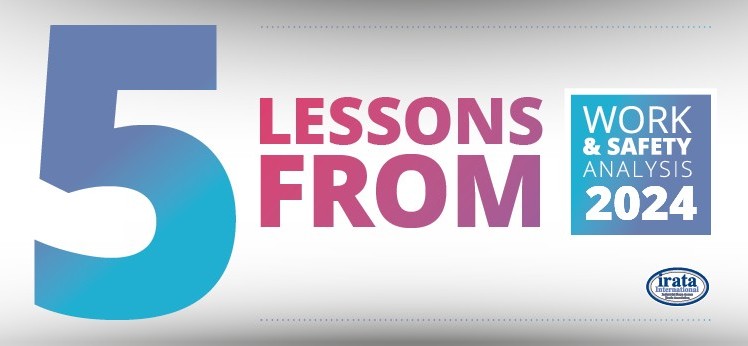Independently authored by Mr David Thomas MSc, BSc(Eng), AKC, CEng, FICE, CFIOSH, IRATA’s Work and Safety Analysis (WASA) 2024 highlights actionable lessons from member company employment, incident, and accident data submitted between January – December 2023, to help rope access companies improve operations and protect their workforces. Download the full version here.
Robust, transparent reporting across all member companies remains critical in building a proactive safety culture and leveraging lessons learned from incidents.
Consider these 5 key lessons to help drive our industry to even higher standards of safety:
1. Addressing Human Factors as a Key Risk Area
Human error, such as lapses in concentration, remains a significant contributor to incidents and highlights the need for greater emphasis on behavioural safety. Efforts to promote accountability while avoiding blame culture can reduce avoidable incidents and build a stronger safety culture amongst the workforce.
2. Harnessing Near-Miss Reporting to Strengthen Safety Practices
Low reporting of near misses limits learning opportunities across the membership. Near-miss reporting offers valuable insights into potential hazards, enabling companies to address issues before they lead to actual incidents. It also provides crucial information for IRATA to share pertinent lessons learned with the broader industry through topic sheets and safety bulletins.
IRATA’s ‘Report a Problem. Prevent a Fatality’ campaign aims to improve incident and near-miss reporting, encouraging a “learning environment where members strive to identify, learn and improve.”
3. Persistent Hazards Require Targeted Solutions
In addition to human error, dropped objects, rope damage, working environment, and failure to identify hazards continue to be recurring risks that require ongoing attention. Members should consider these common themes in their training and procedures and take a proactive approach to prevention.
To assist companies in applying consistent and effective risk management practices, IRATA provides a library of guidance targeting many of these concerns within focused ICOP Annexes and Topic Sheets. These common themes have been implemented into the A&I Workshop agendas, where documented discussions allow IRATA to review possible changes to the TACS, increase awareness and aim to reduce recurrence.
4. Consistency Drives Improvement
Reliable and consistent incident reporting, particularly for near misses, is critical for identifying trends and sharing lessons learned across the industry.
More precise data categories and criteria for defining “dangerous occurrences” implemented in IRATA’s new incident reporting form and associated guidance will facilitate a better understanding of incident patterns and measurement of safety improvements. Incorporated and accessible guidance within the Incident Report [FM-021] is intended to remove barriers to accurate reporting.
Encouraging incident reporting prevails as a primary focus for IRATA’s Health and Safety Committee, with an ongoing campaign to encourage open discussion, without blame, targeting company reporting culture on a global scale.
5. Leading Indicators for Proactive Prevention
“Accident and incident statistics are, by their nature, ‘lagging’.” Prevention must always be an emphasis in safety conversations, where teams are empowered to identify and mitigate risks before they lead to incidents.
Identifying and incorporating key ‘leading’ indicators through proactive safety measures like on-the-ground safety observations, safety conversations, and pre-task briefings, and periodically reviewing their impact, can help companies shape a safer future.
IRATA remains committed to the continued cultivation of a strong safety culture and promoting continuous learning across the rope access industry. Members are encouraged to report all incidents to help inform and educate others, preventing incidents and potentially saving lives.
We would like to thank Mr David Thomas for authoring this report and offering recommendations that drive ongoing improvement. We also extend our gratitude to our members for their dedication to compiling and submitting the necessary data for the collation of the WASA 2024.

